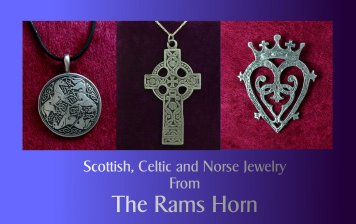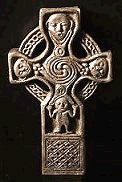
HOME | home
Folk Music Index | Christmas Carols | The Celtic Christian Tradition | A Shepherds Songbook | Celtic Christian Links and Lore | Christian Thought | Being 'spiritual but not religious'? | The Ten Commandments | The Good Shepherd | Christian Communities in Peril | Humanism | Jesus and Reason | The Great Fundamentalist Hoax | Why This Scientist Believes in God | My Problem with Christianism | Who Owns Christianity? | Blood Thirsty Christians??? | Birth and Death | Celtic Christians | Celtic Crosses | Women in the Church | Christ by William Dyce | Stobo Kirk | Psalms of David | Saint Clement's Church | Rossyln Chapel | The First Presbyterian Church | Hurlbut Memorial Community Church | Christmas Eve 2009 | Photos of Church Activities | Postcards of Hurbut Church | Hurlbut Photos | Hurlbut Photos 2 | Hurlbut Photos 3 | Pentecost Sunday 2010 | Annual Picnic 2010
Celtic Crosses
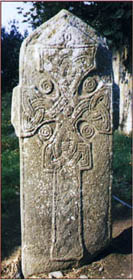
What is the Origin of the Celtic cross? What does it Symbolize?
The Celts were the ancient inhabitants of much of Europe. A spiritual people, their rich mythology and symbology later merged with the Christian beliefs they embraced to create a distinctive art seen especially in Ireland and Scotland. The Celtic Cross is known throughout the world as the emblem of Celtic Christianity and it can be considered the symbol of Celticness itself. Celtic Crosses began to appear during the fifth century AD. Some say it's shape is derived from a pagan sun symbol, the sunwheel,which later became a symbol of the Christian Godhead.The sunwheel was originally a cross surrounded by a circle with a center stone representing the sun and "mock suns" at the four quarters. The cross represents eternal life; it's horizontal axis being the earthly world and the vertical axis the heavenly world coming together as the union of heaven and earth.The oldest Celtic crosses were carved into large slabs of rock that lay flat on the ground. Later versions stand in an upright position, with rock carved away from the cross. Tenth-century Irish crosses were sometimes capped with a pitched roof. Celtic crosses were often decorated with interlaced knot work, spirals, key patterns, animal figures, foliage designs, and Biblical stories. Some crosses were memorials, inscribed with names of individuals; modern Celtic crosses are often used as tombstones in Irish churchyards.
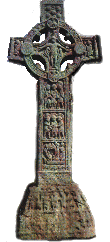
Some suggest that the Celtic cross is derived from the Chi Rho symbol popularized by the Christian Roman emperor Constantine. "Chi" and rho" are the first two letters of "Christ" in Greek, and the overlapped letters are similar to the equal-limbed cross at the center of the Celtic cross.
But no one is certain about where the distinctive circle of the Celtic cross came from or what it means. Among some ancient peoples, a circle was used to represent the moon, and a circle with a cross symbolized the sun. Thus, the circle in the Celtic cross could have been a pagan moon or sun that was appropriated by early Christians to help convert the Celtic population.
An Irish legend tells how St. Patrick created the first Celtic cross by drawing a circle over a Latin cross to incorporate a pagan moon goddess symbol. For an Irish Catholic, the circle in the Celtic cross may be a symbol of eternity and the endlessness of God's love. It can even represent a halo emanating from Christ.
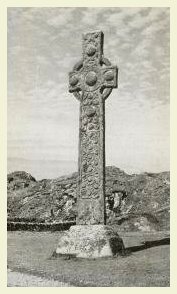
Is the Celtic Cross a Pagan or Christian Symbol?
Many claim it is, especially Neo-Pagans, who now use it freely for their own purposes. Some Christians, especially fundamentalists, are terribly afraid that they might be right and want nothing to do with it if it is tainted by Pagan associations. But the vast majority who use the Celtic Cross are Christian and unconcerned that there is any controversy.
All the historical examples of actual "Celtic Crosses" are from indisputably Christian contexts. The Aberlemno Stone in Angus, the great High Crosses at Clonmacnoise, Monasterboise, Kells, Iona and many other medieval monastic sites are all clearly made in Christian times, under Christian patronage and according to conventional Christian iconography. So where does this claim of paganism come from?
Henry O'Neill, in his 1857 book Illustrations of the Most Interesting of the Sculptured Crosses of Ancient Ireland writes, "I think that ancient Irish art was pagan, and was continued during the Christian period, just as the peculiar form of the Irish cross is pagan, or as the names of the months, or of the days of the week are pagan; these, and a great deal more of paganism, having continued, owing to the tenacity with which a people retain their general habits and ideas."
O'Neill was not himself pagan, as much of his writing contains a Christian piety that would refute such a suggestion. Rather he is expressing pride in a noble antiquity for Irish art. During the 19th century Celtic Revival, much was said and written about native cultural survivals from pre-Christian times. "Pre-Christian" would also be pre-Norman and pre-English domination. It must be remembered that at this time Ireland was reinventing itself. The trauma of famine and foreign rule was fresh. Many ancient Gaelic myths and legends were revived to serve the cause of a renewed sense of national identity and pride in the past.
A renewed interest in Celtic Christianity was part of this movement as well. The Celtic Church refers to the Church as it was in Ireland and Great Britain in the early medieval times, when it was considered isolated from Rome and developed a distinctly Celtic spirituality. People are not of one mind about this, as they rarely are about religious matters. But one thing that came out of this was the belief by some that the pagan Druidic religion of the Celts had clairvoyantly anticipated the Gospels. Legends were retold and refashioned in the light of emerging ideas and theories from archeology and anthropology. The similarity of the Celtic Cross to ancient symbols such as various Sun symbols and the swastika rather firmly established the notion that these pre-Christian signs were prototypes of the Christian Celtic Cross. The mystics of the movement added this archeological interpretation to their conviction that God had blessed the Druids with prophetic knowledge of the coming of Christ.
Some observers see any quartering of a circle as a Celtic Cross. The chambers of the Neolithic tomb at Newgrange or the arrangement of standing stones. Examples like these, though they be easily dismissed as coincidence, are "proof" to some that the Celtic Cross is of greater antiquity than Christianity and obviously originally pagan. Setting aside the question of validity of that belief, let us see what "spin" has been put on that belief in modern times. To the Celtic Christian of the early 20th century, the pagan roots of the Celtic Cross were a source of joy and wonder. It is evidence of the enlightenment and spiritual sensitivity of their pagan ancestors and of God's grace towards them. Today you are more likely to hear the story told that the (bad) Christians stole the symbol from its rightful pagan heritage and that this appropriation was done with the sinister motives of tricking the convert by changing the meaning of familiar symbols so that his conversion might require less coercion.
Ironically, the Pagan Roots of the Celtic Cross is essentially a Christian legend in its development. It is only in the last quarter of the 20th century that the "Christians stole it" spin of the story has become widespread, promoted mainly by those who make no secret of their distrust of Christianity. But there is more irony yet. The negative version of the story is also spread by some Christians, who unaware of the Celtic Revival version, believe the Neo-Pagan version of the story as true and feel compelled to spread the alarm, lest their fellow Christians unwittingly offend God by use of a pagan symbol.
So my message is "lighten up!" If you are Christian or Pagan I hope this little essay helps answer some questions. Attempts to deny or taint the Christian heritage of the Celtic Cross are misguided, but it is also a mistake to insist that any faith has an exclusive claim on this powerful symbol. And remember to keep things in perspective. The substance of religion is faith and love, not symbols.
Stephen Walker
6 October 2002
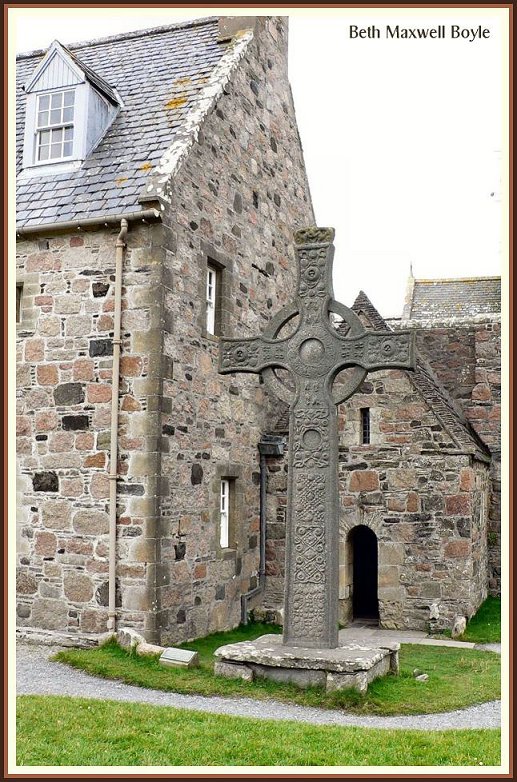
BOOKS FOR FURTHER REFERENCE
I own both of these books and love having them in my library.
Author: Bryce, Derek
Paperback; Illustrations
220 pages
Published: December 1995
Red Wheel/Weiser
ISBN: 087728850X
Symbolism of the Celtic Cross, tells the history of Celtic crosses and is fully illustrated. The stories, symbols, and images come from the many places Celts traveled and settled, including Brittany, Wales, Scotland, the Isle of Man, Cumbria, France, Cornwall, and Ireland. Derek Bryce, author of Symbolism of the Celtic Cross, has studied mysticism and comparative religion for many years. He translated Wieger's Les Peres du System Taoiste as Wisdom of the Taoist Masters, and is the author of Celtic Folk-Tales from Amorica and Celtic Legends of the Beyond.
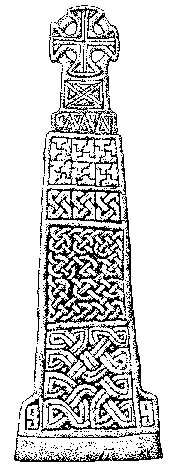
Author:John Sharkey.
Paperback; Illustrations
144 pages
Published: 1998
Llanrwst : Gwasg Carreg Gwalch, 1998.
ISBN:0-86381-489-1
This is a survey of all the Celtic crosses and decorated fragments in Wales, together with a study of the religious and cultural background, icongraphy design and sculpture. A survey of all the Celtic crosses and decorated fragments in Wales.


Links
"Pasce Oves Meas"
Feed my sheep
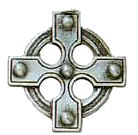
Gum beannaicheadh an Tighearna thu, agus gun gleidheadh e thu:
Gun tugadh an Tighearna air a aghaidh dealrachadh ort, agus biodh e gràsmhor dhut:
Gun togadh an Tighearna suas a ghnùis ort, agus gun tugadh e sìth dhut.
May the Lord bless you and keep/protect you,
May the Lord reveal His face unto you and have mercy.
May the Lord turn His Face unto and give you peace.
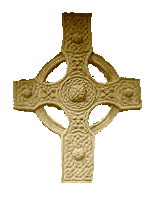
Beannachd Dia dhuit
(blessings of God be with you)
copyright 2002 , Jim & Beth Boyle, All Rights Reserved
No part of this website may be used for any purpose ( including using images )
without written consent from The Rams Horn

